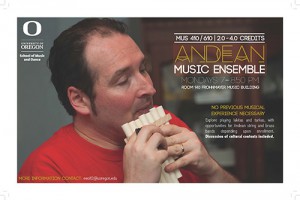MUS 358: Music in World Cultures
TR 8:30-9:50 AM Room: CLS 250 + Discussion Section
 Beyond humanly organized sound, music is a tool to think with. The different ways in which humans use and talk about music can teach us much about ourselves and each other. In this class, you will learn how people raised in a variety of cultures produce and perceive music-dance as well as what concepts scholars have developed to understand these expressions more generally. Beyond exposing you to musics that you may not be familiar with, my goal is for you to apply the concepts you learn here to think critically about the multiple types of cultural performances you experience in your own lives. This course fulfills the IC (International Cultures) Multicultural Requirement.
Beyond humanly organized sound, music is a tool to think with. The different ways in which humans use and talk about music can teach us much about ourselves and each other. In this class, you will learn how people raised in a variety of cultures produce and perceive music-dance as well as what concepts scholars have developed to understand these expressions more generally. Beyond exposing you to musics that you may not be familiar with, my goal is for you to apply the concepts you learn here to think critically about the multiple types of cultural performances you experience in your own lives. This course fulfills the IC (International Cultures) Multicultural Requirement.
All reading and listening materials will be made available through the Canvas course site. Online quizzes during class means that you will need some type of smart device like a phone or laptop.
T 2:00-3:20 PM, plus half-hour sectional based on interest
 One intellectual current within ethnomusicology is the idea of bi-musicality, or the ability to be fluent in more than one musical system. This course emphasizes the practice of music-dance from a specific region/culture and asks students to reflect on how this practice may compare with the musical systems they already have experience with. Students will be asked to take an embodied approach in learning. At the end of the term, students will share what they have learned with others through an end-of-term presentation. Students who are interested in taking the class for additional credit (beyond 2.0 credits) are required to do additional work such as write an end-of-term research paper or produce a creative project related to region in question.
One intellectual current within ethnomusicology is the idea of bi-musicality, or the ability to be fluent in more than one musical system. This course emphasizes the practice of music-dance from a specific region/culture and asks students to reflect on how this practice may compare with the musical systems they already have experience with. Students will be asked to take an embodied approach in learning. At the end of the term, students will share what they have learned with others through an end-of-term presentation. Students who are interested in taking the class for additional credit (beyond 2.0 credits) are required to do additional work such as write an end-of-term research paper or produce a creative project related to region in question.
This term is dedicated to learning about the music-dance traditions of the South Central Andes, a region in which I have spent time doing field work. Several of these traditions use wind and percussion instruments that are relatively easily learned (lakitas/panpipes and tarkas/duct flutes), and everyone will learn a tune in these ensembles. It may be possible to explore two other traditions, the Andean string orchestra (quena/guitar/mandolin/flute/violin/charango/accordion) and the Andean brass band (trumpet/baritone/tuba/clarinet/ sax/trombone), depending upon what skills students bring with them to the class. All students will be expected to sing and perform basic dance steps. No prior musical experience necessary.